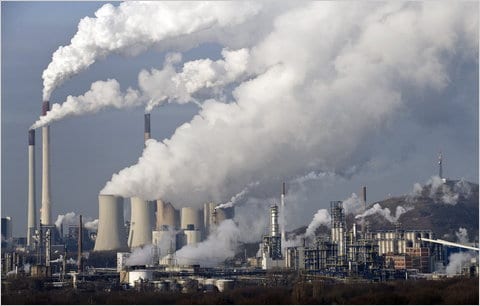The 46,000MW of black and brown coal fired generation currently in service in Germany will be worthless in little more than a decade if the country adopts the targets embraced at the Paris climate change conference, a new analysis from Barclays says.
The analysis, from leading energy analyst Mark Lewis, says coal fired power generation would have to be almost completely eliminated by 2030 in a scenario that would require a substantial carbon price (€45/t) and the end to the current energy market design.
The conclusions of the report should not be a surprise, but are important because the fossil fuel industry appears to remain in complete denial, hoping that the Paris climate agreements amount to a “fell-good” gathering that will have no follow through.
But the latest data on soaring global temperatures, and the biggest jump in greenhouse gas emissions on record, suggests this hope is misplaced. Or at least should be. The analysis has implications too, for Australia, which faces a similar transition to Germany, which a growing level of renewables on top of a huge surplus in coal generation, and no effective carbon price to influence energy choices.
Even the most ambitious fossil fuel generators in Australia, such as AGL Energy, say their coal assets, particularly their brown coal assets, will continue generating as late as 2048. The Barclays scenario shows that this would be impossible. Indeed, The Climate Institute says all coal fired generation must cease by 2035 at the latest.
But back to the Barclays report. It suggests that coal will have to be displaced to meet greenhouse gas targets embraced by the EU and implied by the Paris agreement. In Germany, under current policies, total generation will reduce by 15 per cent under energy efficiency measures and its target for 50 per cent renewables.
To meet the emissions goals, however, that remaining fossil fuel generation will have to come nearly exclusively from gas, meaning a carbon price is required to upturn the “merit order”. Currently, the lack of a carbon price and the presence of cheap coal means that gas fired generation is marginalised.
Lewis says by 2030, Germany will have dumped its energy system- where a plant is longer dispatched on the basis of its relative cost for the next half hour – and replace it with one where renewable generation is backed up by energy storage and sophisticated demand-side responses facilitated by smart-grid technologies.
“It will still be some time before we reach that world and before the last half hour of competitively priced power is dispatched,” he notes.
But he says this will occur, which is why the biggest utilities in Germany, E.ON and RWE, have decided to split their assets into new and old companies, jettisoning their old “centralised” generation assets to focus on a new business centred around solar, storage, smart grids and electric vehicles.
“The Energiewende requires a complete strategic reprioritization away from conventional generation and towards renewable energy so that the companies can prepare for the power system of the future,” Lewis says.
He believes that only a handful of coal plants would still be operating by 2030 – the Datteln 4 (1.1GW) and Maasvlakte 3 (1.1GW), and the Westfalen E (765MW) hard coal plants, all of which have very high efficiency rates of 46 per ent.
The only lignite plant still running would be the BoA 2 & 3 units at Neurath (2.1GW), which have a very efficiency rate for lignite plant of 43 per cent. The value of the brown coal generators for both E.ON and RWE would be wiped out completely, and considerably reduced for hard coal. The value of gas-fired generation, though, would increase.

Barclay’s base-case scenario assumes current targets, an average baseload power price over 2020-30 of €28/MWh in real terms (constant 2019 €), and an average EUA price in real terms of only €5/MWh.
Its 2°C scenario would require an average EUA price of at least €45/t in real terms (constant 2019 €) and hence average baseload prices of €55-60/MWh (again in constant 2019 €) over 2021-30.
By 2030, total coal and lignite output in the entire German market is only 50TWh (versus 190TWh in our base case) while total German gas-fired output in 2030 is doubled from the base case to 150TWh.
“The implications of our analysis … of the German power sector – especially when taken together with Germany’s own 2030 targets for energy efficiency and renewable energy – are that very little coal and lignite could run by 2030,” Lewis writes.
Gas displaces coal and lignite over the decade while coal and lignite plants see lower average utilization rates and shorter average operating lives, with what little plant is running by the end of the next decade pushed to the margin.











